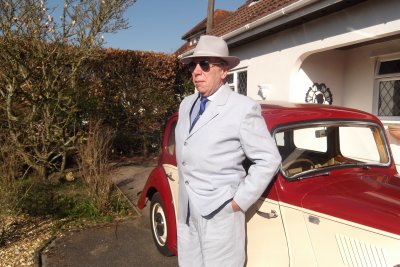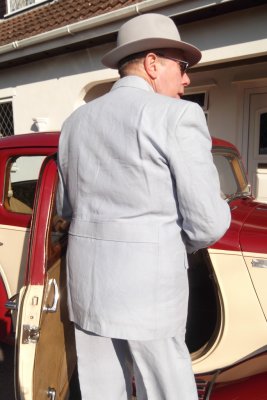Matt Deckard
Man of Action
- Messages
- 10,046
Placement and proportions for the belt back suit
Matt Deckard Uncategorized November 1, 2017 4 Minutes

This one comes as more of a demand from a few friends who needed some answers ASAP as they saw the Simon James Cathcart ‘Chevalier’ suit had an action back that was the same design I’d worked out a few years ago (the Indiana Jones Raiders of the Lost Ark back). The friends asked me what I saw wrong and SJC thanked me for explaining how to properly make the back of the ‘Chevalier’ suit functional and accurate to what was made in the 1930s. They are currently in the midst of making the new design for their clients.
To illustrate, below are the SJC jacket and an original vintage jacket.
The same idea, yoke on the back, four pleats under the yoke and above the belt, with a center inverse box pleat.
The first one shown is the incorrect repro styling. (SJC Pre redesign design) The belt sits inches below the defined waistline set by the center button on the front of the jacket. The yoke at the shoulders is too long and the belt itself is much too narrow for the period, and for a proportional look. When worn it will cause the belt to rise to meet the waistline set by the center button on the front.
The second one shown is the correct (Vintage example) The belt sits directly below the center button at the front of the jacket. When worn, the belt will hold it’s position and the back will properly close.


Now to why the changes are being made, and the reasoning and logic to action back and belt back design. I’ve been asked about the SJC suit front as well and I think it’s a high stance two button converted to a 3 button, but that’s for another post.
Talking to a couple tailors I learned a lot more about armholes and body fit from when I began my quest to have a suit that fits well enough to make me feel as though I’m wearing pyjamas. I do like the roundtables in New York thanks to a friend of mine. Now to the demanded info!
The half belted back and it’s placement.
When you put a belt on a jacket, the front and back of the belt is level. Usually it’s going to be directly at the wearers true waist. There have been dropped waist version in the 1910s and 1920s, and in the 1930s you’ll see the belts put on jacket more so at the true natural waist of the wearer.
Rather than showing exploded drawings of suit pieces, I’ll show you styles on people and hopefully make clear the logic behind the belting.
A belt all the way around the jacket clearly defines where the waist of the wearer is front and back. If there is a center button at the waist of the jacket, the button can often go through the button on a norfolk jacket that has a cloth belt, or like in the military stylings, the belt can be directly below. the center button but is still showcasing a uniform waistband around the jacket.
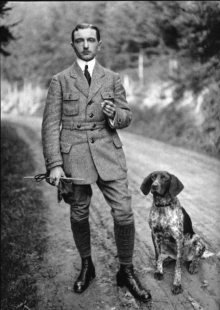
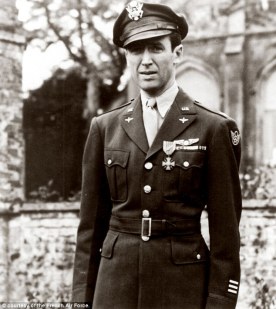

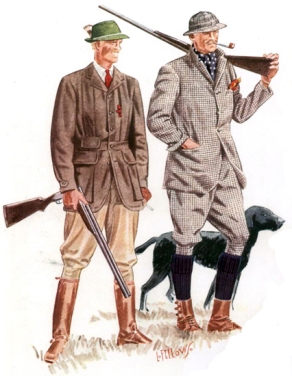


There are examples of where the belt is actually dropped lower than the actual waist, but I’ve seen that it’s Proportional because the trouser have a lower waist and it’s the look of a trend of the time. — I’ll add photos of that shortly.
There are reasons to break the rule of where to put the belt when it’s going on the back of a jacket, but I’ve found if you do this, it’s for aesthetics rather than function.
The Jacket below has a center button defining the waist in the front but the rear belt is a bit lower than where the center button is placed. You can see the discrepancy in the waist placement by looking at the side pockets.
I’ve seen this mostly done on new models as I think the designers are separating the placement of the jacket’s front and back waistline, placing the belt nearer to where modern low waisted trowsers haver their waistling.
When paired with an action back, or even without, moving while wearing a jacket where the rear waistline is lower than the front waistline causes the belt to raise and sometimes hang higher or catch higher on the individual and bunch up the jack of the jacket.


There are also belted jackets where there is no center button placement, commonly these jackets are made to have both front buttons fastened and the belt in the rear is between the two buttons in the front.
When it came to me working to get proportions and placement correct, I went on a binge of not just tailoring books, but evidence on screen just to see action belt backs in action.
Below are several images from the 1934 Movie Transatlantic-Merry-Go-Round. Note again that the top seam of the belt is placed exactly where the button placement in the front lies. I’ve measured a few three button suits from the 1930s and when I wanted my own made, I went with that logic to keep my action backs functioning properly.

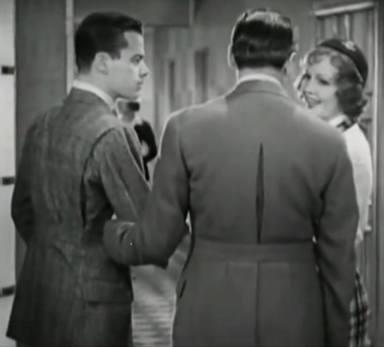
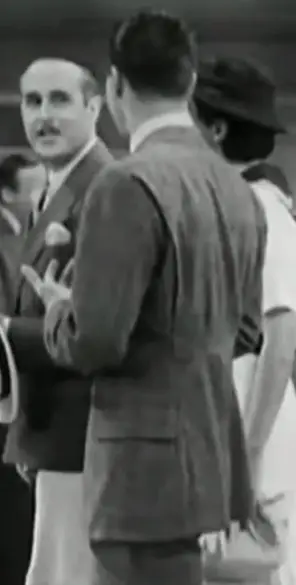
Some Images from 1933 The Clark Gable movie, Dancing Lady. I love this suit! If you watch the movie, the belt is exaclty below where the center button placement of the front lies.
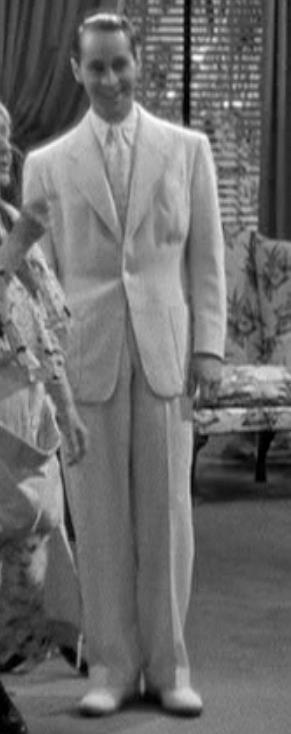
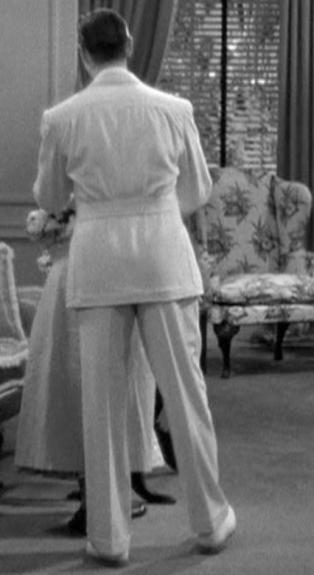

Belted back Double Breasted jacket with four buttons. The two top buttons sit at the wearer’s natural waistline. The seam of the belt in the back, when measured from the bottom of the hem up, is at the same height as the top buttons stance.

I went with a 2 inch belt and the yoke is not too large, but it was a science to get the proportions correct on that as well. Too wide and it’s very 1970s looking. Too narrow and it looks like a shoestring pasted to the back.
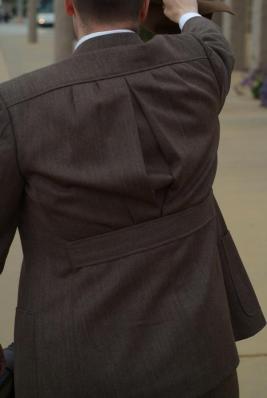
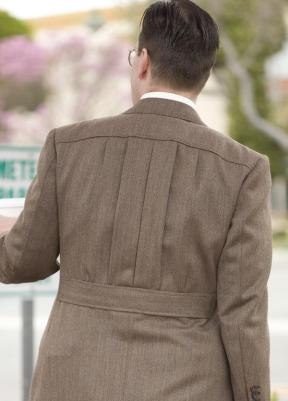
I’m going to continue editing this with more visuals as I have a lot written that I don’t think will become clear without the right imagery.
Matt Deckard Uncategorized November 1, 2017 4 Minutes

This one comes as more of a demand from a few friends who needed some answers ASAP as they saw the Simon James Cathcart ‘Chevalier’ suit had an action back that was the same design I’d worked out a few years ago (the Indiana Jones Raiders of the Lost Ark back). The friends asked me what I saw wrong and SJC thanked me for explaining how to properly make the back of the ‘Chevalier’ suit functional and accurate to what was made in the 1930s. They are currently in the midst of making the new design for their clients.
To illustrate, below are the SJC jacket and an original vintage jacket.
The same idea, yoke on the back, four pleats under the yoke and above the belt, with a center inverse box pleat.
The first one shown is the incorrect repro styling. (SJC Pre redesign design) The belt sits inches below the defined waistline set by the center button on the front of the jacket. The yoke at the shoulders is too long and the belt itself is much too narrow for the period, and for a proportional look. When worn it will cause the belt to rise to meet the waistline set by the center button on the front.
The second one shown is the correct (Vintage example) The belt sits directly below the center button at the front of the jacket. When worn, the belt will hold it’s position and the back will properly close.


Now to why the changes are being made, and the reasoning and logic to action back and belt back design. I’ve been asked about the SJC suit front as well and I think it’s a high stance two button converted to a 3 button, but that’s for another post.
Talking to a couple tailors I learned a lot more about armholes and body fit from when I began my quest to have a suit that fits well enough to make me feel as though I’m wearing pyjamas. I do like the roundtables in New York thanks to a friend of mine. Now to the demanded info!
The half belted back and it’s placement.
When you put a belt on a jacket, the front and back of the belt is level. Usually it’s going to be directly at the wearers true waist. There have been dropped waist version in the 1910s and 1920s, and in the 1930s you’ll see the belts put on jacket more so at the true natural waist of the wearer.
Rather than showing exploded drawings of suit pieces, I’ll show you styles on people and hopefully make clear the logic behind the belting.
A belt all the way around the jacket clearly defines where the waist of the wearer is front and back. If there is a center button at the waist of the jacket, the button can often go through the button on a norfolk jacket that has a cloth belt, or like in the military stylings, the belt can be directly below. the center button but is still showcasing a uniform waistband around the jacket.






There are examples of where the belt is actually dropped lower than the actual waist, but I’ve seen that it’s Proportional because the trouser have a lower waist and it’s the look of a trend of the time. — I’ll add photos of that shortly.
There are reasons to break the rule of where to put the belt when it’s going on the back of a jacket, but I’ve found if you do this, it’s for aesthetics rather than function.
The Jacket below has a center button defining the waist in the front but the rear belt is a bit lower than where the center button is placed. You can see the discrepancy in the waist placement by looking at the side pockets.
I’ve seen this mostly done on new models as I think the designers are separating the placement of the jacket’s front and back waistline, placing the belt nearer to where modern low waisted trowsers haver their waistling.
When paired with an action back, or even without, moving while wearing a jacket where the rear waistline is lower than the front waistline causes the belt to raise and sometimes hang higher or catch higher on the individual and bunch up the jack of the jacket.


There are also belted jackets where there is no center button placement, commonly these jackets are made to have both front buttons fastened and the belt in the rear is between the two buttons in the front.
When it came to me working to get proportions and placement correct, I went on a binge of not just tailoring books, but evidence on screen just to see action belt backs in action.
Below are several images from the 1934 Movie Transatlantic-Merry-Go-Round. Note again that the top seam of the belt is placed exactly where the button placement in the front lies. I’ve measured a few three button suits from the 1930s and when I wanted my own made, I went with that logic to keep my action backs functioning properly.



Some Images from 1933 The Clark Gable movie, Dancing Lady. I love this suit! If you watch the movie, the belt is exaclty below where the center button placement of the front lies.



Belted back Double Breasted jacket with four buttons. The two top buttons sit at the wearer’s natural waistline. The seam of the belt in the back, when measured from the bottom of the hem up, is at the same height as the top buttons stance.

I went with a 2 inch belt and the yoke is not too large, but it was a science to get the proportions correct on that as well. Too wide and it’s very 1970s looking. Too narrow and it looks like a shoestring pasted to the back.


I’m going to continue editing this with more visuals as I have a lot written that I don’t think will become clear without the right imagery.
Last edited:
